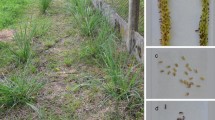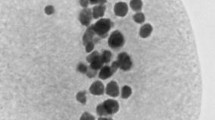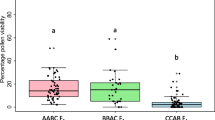Abstract
Agamospermous dandelions of hybrid origin between a native sexual diploid species (Taraxacum platycarpum Dahlst. or T. japonicum Koidz.) and an alien agamospermous triploid [T. officinale Weber and T. laevigatum (Willd.) DC.] are now widely distributed throughout mainland Japan. These hybrid dandelions are known to be genetically variable. We hypothesized that this variability is maintained by repeated ongoing hybridization, based on the fact that triploid dandelions not only produce seeds agamospermously, but also produce some functional pollen grains that are able to sire seeds of sexual dandelions. To test this hypothesis, we examined whether heads of Japanese diploid dandelions produce new hybrid seeds after fertilization by pollen from triploid agamosperms under field conditions. One of the 430 tested plants grown from sexual dandelion seeds had morphological and molecular characteristics, which are consistent with a hybrid origin. The plant formed a hybrid surrounded by many individuals having recurved involucral bracts, in which frequency of T. officinale was very low (3.5 %). Cytological data and bagging experiments demonstrate triploidy and asexual seed production of the hybrid. Taken together, these results supported that the new hybrid is probably derived from a backcross of a hybrid to the native sexual species. Our findings provide evidence for the evolution of a new agamosperm through interspecific hybridization as a contemporary population process.





Similar content being viewed by others
References
Babcock EB, Stebbins GL (1938) The American species of Crepis: their interrelationships and distribution as affected by polyploidy and apomixis. Carnegie Institution of Washington No. 504
Bicknell RA, Koltunow AM (2004) Understanding apomixis: recent advances and remaining conundrums. Plant Cell 16:S228–S245. doi:10.1105/tpc.017921
Clay K, Kover PX (1996) The Red Queen hypothesis and plant/pathogen interactions. Annu Rev Phytopathol 34:29–50. doi:10.1146/annurev.phyto.34.1.29
Grant V (1981) Plant speciation, 2d edn. Columbia University Press, New York
Hamilton WD (1980) Sex versus non-sex versus parasite. Oikos 35:282–290
Hoya A (2010) Evolution of hybrid dandelions. In: Muranaka T, Ishihama F (eds) Ecology of introduced organisms—adaptive evolution into new environments and possible counter measures. Bun-ichi Sogo Shuppan, Tokyo, pp 217–246 (in Japanese)
Hoya A, Shibaike H, Morita T, Ito M (2004) Germination and seedling survivorship characteristics of hybrids between native and alien species of dandelion (Taraxacum). Plant Species Biol 19:81–90. doi:10.1111/j.1442-1984.2004.00104.x
Maynard Smith J (1978) The evolution of sex. Cambridge University Press, Cambridge
Mogie M (1992) The evolution of asexual reproduction in plants. Chapman & Hall, London
Morita T (1995) Taraxacum Weber ex F. H. Wigg. In: Iwatsuki K, Yamazaki T, Boufford DE, Ohba H (eds) Flora of Japan, vol IIIb. Kodansha, Tokyo
Morita T (2012) Natural history of naturalized plants: ecology of invasion and disturbance. Hokkaido University Press, Hokkaido (in Japanese)
Morita T, Sterk AA, den Nijs JCM (1990a) The significance of agamospermous triploid pollen donors in the sexual relationships between diploids and triploids in Taraxacum (Compositae). Plant Species Biol 5:167–176. doi:10.1111/j.1442-1984.1990.tb00201.x
Morita T, Menken SBJ, Sterk AA (1990b) Hybridization between European and Asian dandelions (Taraxacum section Ruderalia and section Mongolica) 1. Crossability and breakdown of self-incompatibility. New Phytol 114:519–529
Nishikawa T, Okazaki K, Uchino T, Arakawa K, Nagamine T (1999) A molecular phylogeny of Lilium in the internal transcribed spacer region of nuclear ribosomal DNA. J Mol Evol 49:238–249. doi:10.1007/PL00006546
Ogawa K, Shibaike H, Deguchi M, Kaneko S, Morita T (2007) Reconsiderations of hybridization between the native and the introduced dandelions and its effects on bio indicator. Man Environ 33:2–12 (in Japanese)
Ooi K, Yahara T (1999) Genetic variation of geminiviruses: comparison between sexual and asexual host plant populations. Mol Ecol 8:89–97. doi:10.1046/j.1365-294X.1999.00537.x
Richards AJ (1973) The origin of Taraxacum microspecies. Bot J Linn Soc 66:189–211
Richards AJ (1986) Plant breeding systems. Allen & Unwin, London
Sato K, Iwatsubo Y, Naruhashi N (2007) Chromosome studies of native lowland diploid species of Taraxacum (Asteraceae) in Japan. Cytologia 73:309–317. doi:10.1508/cytologia.72.309
Schön I, Martens K, van Dijk P (eds) (2009) Lost sex, vol 58. Springer, Heidelberg
Shibaike H (2005) Agamospermous triploids meet sexual diploids: a case study of Taraxacum officinale in Japan. Biol Sci 56:74–82 (in Japanese)
Shibaike H, Morita T (2002) Spreading hybrid dandelions. Gene 56:16–18 Shokabo, Tokyo (in Japanese)
Shibaike H, Akiyama H, Uchiyama S, Kasai K, Morita T (2002) Hybridization between European and Asian dandelions (Taraxacum section Ruderalia and section Mongolica) 2. Natural hybrids in Japan detected by chloroplast DNA marker. J Plant Res 115:321–328. doi:10.1007/s10265-002-0045-7
Shibaike H, Uetake T, Kusumoto Y, Yano H, Ide M (2005) Genetic diversity of hybrid dandelions and their clone distribution in Kanto plain. Environ Inform Sci 19:279–284 (in Japanese)
Shimizu T (ed) (2003) Naturalized plants of Japan. Heibonsha Ltd., Tokyo, p 337 (in Japanese)
Stebbins GL (1971) Chromosomal evolution in higher plants. Edward Arnold (Publishers) Ltd, London
Strasburger E (1905) Typische und allotypische Kernteilung. Histologische Beiträge zur Vererbungsfrage. Jahrbücher für wissenschaftliche Botanik 42:1–71
Tas ICQ, Van Dijk PJ (1999) Crosses between sexual and apomictic dandelions (Taraxacum). I. The inheritance of apomixis. Heredity 83:707–714. doi:10.1046/j.1365-2540.1999.00619.x
Van Oostrum H, Sterk AA, Wijsman HJW (1985) Genetic variation in agamospermous microspecies of Taraxacum sect. Erythrosperma and sect. Obliqua. Heredity 55:223–228
Verduijn MH, van Dijk PJ, van Damme JMM (2004) The role of tetraploids in the sexual–asexual cycle in dandelions (Taraxacum). Heredity 93:390–398. doi:10.1038/sj.hdy.6800515
Watanabe M (1997) Identifification of hybrid dandelion by allozyme polymorphism: alien dandelions as a compilospecies. Study Species Biol 21:43–47 (in Japanese)
Watanabe M, Maruyama Y, Serizawa S (1997a) Hybridization between native and alien dandelions in the western Tokai district: (2) frequency and morphological characters of the hybrid between Taraxacum platycarpum and T. laevigatum. J Jpn Bot 72:352–356 (in Japanese with English summary)
Watanabe M, Maruyama Y, Serizawa S (1997b) Hybridization between native and alien dandelions in the western Tokai district: (1) frequency and morphological characters of the hybrid between Taraxacum platycarpum and T. officinale. J Jpn Bot 72:51–57 (in Japanese with English summary)
Whitton J, Sears DJ, Baack EJ, Otto SP (2008) The dynamic nature of apomixis in the angiosperms. Int J Plant Sci 169:169–182. doi:10.1086/523369
Yahara T (1990) Evolution of agamospermous races in Bohemeria and Eupatorium. Plant Species Biol 5:183–196
Yamano M, Shibaike H, Hamaguch T, Ide M (2002) Analysis on the distribution patterns of hybrid dandelions (Taraxacum) in Japan collaborated with the “Environmental Indicator Species Survey (Survey of Common Wildlife)”. Environ Inform Sci 16:357–362 (in Japanese with English summary)
Yamano M, Shibaike H, Ide M (2004) Analysis on relationships between landscape structure and distribution patterns for native and hybrid dandelions (Taraxacum) in Tsukuba City, Ibaraki Pref. J Jpn Inst Landsc Archit 67:587–590 (in Japanese with English summary)
Acknowledgments
We are grateful to Makiko Mimura for her valuable advice; to Ikumi Umeda and other members of the Department of Biology, Aichi University of Education, for their kind help in fieldwork; to Firouzeh Javadi and the reviewers for editorial comments. This work was funded in part by the Grant-in-Aid for JSPS Fellows 24.4061.
Author information
Authors and Affiliations
Corresponding author
Rights and permissions
About this article
Cite this article
Mitsuyuki, C., Hoya, A., Shibaike, H. et al. Formation of a hybrid triploid agamosperm on a sexual diploid plant: evidence from progeny tests in Taraxacum platycarpum Dahlst.. Plant Syst Evol 300, 863–870 (2014). https://doi.org/10.1007/s00606-013-0925-4
Received:
Accepted:
Published:
Issue Date:
DOI: https://doi.org/10.1007/s00606-013-0925-4




